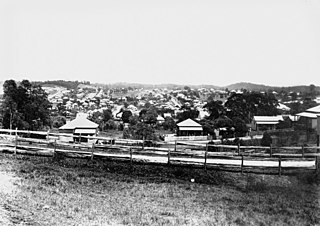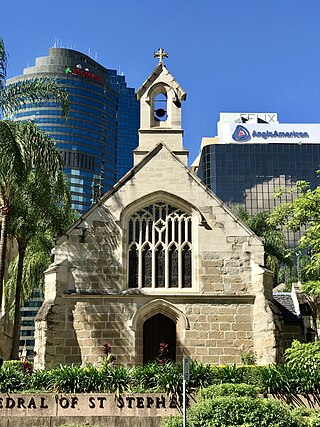
Wooloowin is a suburb in the City of Brisbane, Queensland, Australia. In the 2016 census, Wooloowin had a population of 3,938 people.

Justice Alfred James Peter Lutwyche, Queen's Counsel was the first judge of the Supreme Court Bench of Queensland.

Lutwyche is a northern suburb in the City of Brisbane, Queensland, Australia. In the 2016 census, Lutwyche had a population of 3,454 people.

Kedron is a northern suburb in the City of Brisbane, Queensland, Australia. In the 2016 census, Kedron had a population of 9,359 people. It is home to the Queensland Fire and Emergency Services headquarters.

Customs House is a heritage-listed customs house at 427 Queen Street, Brisbane CBD, Brisbane, Queensland, Australia. It was designed by Charles H McLay and built from 1886 to 1889 at a cost of £38,346 by John Petrie & Son. It was originally used for the collection of customs duty and was opened in 1889, when Queensland was a British colony, replacing the original Customs House located at Petrie Bight. It was added to the Queensland Heritage Register on 7 February 2005.

Kalinga is a suburb in the City of Brisbane, Queensland, Australia. In the 2016 census, Kalinga had a population of 2,126 people.

All Saints Anglican Church is a heritage-listed church at 32 Wickham Terrace, Spring Hill, City of Brisbane, Queensland, Australia. First founded in 1862, the current building designed by Benjamin Backhouse was completed in 1869, making it the oldest Anglican church in Brisbane. For most of its history, it has been identified with the High Church or Anglo-Catholic tradition within Anglicanism. It was added to the Queensland Heritage Register on 21 October 1992.

St Andrews Anglican Church is a heritage-listed churchyard at 160 Vulture Street, South Brisbane, City of Brisbane, Queensland, Australia. It was designed by Andrea Stombuco and built from 1878 to 1932. It was added to the Queensland Heritage Register on 21 October 1992.

St Matthews Anglican Church is a heritage-listed church and cemetery at 35 Church Road, Mitchelton, City of Brisbane, Queensland, Australia. It was designed by Charles Tiffin and built from 1867 to 1869 by Mr Mahoney. It is also known as Grovely Church, as it is within the Parish of Grovely. It was added to the Queensland Heritage Register on 21 October 1992.

St Patricks Church is a heritage-listed Roman Catholic church at 58 Morgan Street, Fortitude Valley, City of Brisbane, Queensland, Australia. It was designed by Andrea Giovanni Stombuco and built from 1880 to 1882 by John Arthur Manis O'Keefe. It was added to the Queensland Heritage Register on 21 October 1992.

Kirkston is a heritage-listed villa at 23 Rupert Street, Windsor, City of Brisbane, Queensland, Australia. It was designed by George Henry Male Addison and built from 1888 to 1889 by John William Young. It was added to the Queensland Heritage Register on 21 October 1992.

Oakwal is a heritage-listed villa at 50 Bush Street, Windsor, City of Brisbane, Queensland, Australia. It was designed by architect James Cowlishaw and built in 1864 by John Petrie with subsequent modifications to c. 1948. It was added to the Queensland Heritage Register on 14 May 1993.

Craigellachie is a heritage-listed detached house at 10 Fosbery Street, Windsor, City of Brisbane, Queensland, Australia. It was built c. 1889 by its owner John Grant, a stonemason. It was added to the Queensland Heritage Register on 21 October 1992.

The Grange is a heritage-listed detached house at 38 Crowther Street, Windsor, City of Brisbane, Queensland, Australia. It was built from c. 1874 to 1877. It was added to the Queensland Heritage Register on 21 October 1992.

Skilmorlie is a heritage-listed detached house at 16 Bryden Street, Windsor, City of Brisbane, Queensland, Australia. It was built from c. 1873 to 1920s. It was added to the Queensland Heritage Register on 15 October 1998.

Bess Street Brick Cottages is a heritage-listed duplex at 22, 25-27 Bess Street, Windsor, City of Brisbane, Queensland, Australia. It was built from c. 1880 to 1930s circa. It is also known as Hedge's Buildings. It was added to the Queensland Heritage Register on 15 December 2000.

Killarney is a heritage-listed detached house at 9 Laurel Street, Enoggera, City of Brisbane, Queensland, Australia. It was built c. 1860s. It was added to the Queensland Heritage Register on 21 October 1992.

Mountview House is a heritage-listed detached house at 37 Leichhardt Street, Spring Hill, City of Brisbane, Queensland, Australia. It was originally built in the 1860s with a new wing added in 1882 designed by Andrea Stombuco. It was added to the Queensland Heritage Register on 13 May 2004.

Old St Stephens Church, also known as the Pugin Chapel, is a heritage-listed Roman Catholic church at 249 Elizabeth Street, Brisbane City, City of Brisbane, Queensland, Australia. It was designed by A W Pugin and built from 1848 to 1850 by Alexander Goold and Andrew Petrie. It was added to the Queensland Heritage Register on 21 October 1992.

The Deanery is a heritage-listed detached house at 417 Ann Street, Brisbane City, City of Brisbane, Queensland, Australia. It sits within the grounds of St John's Cathedral, Brisbane. It was built c. 1853 by Andrew Petrie and renovated in c. 1909 to a design by Robin Dods. It is also known as Adelaide House. It was added to the Queensland Heritage Register on 21 October 1992.



























